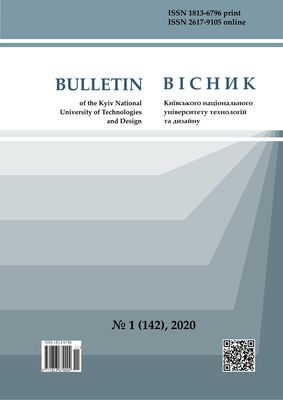THE ECO-SAFETY TECHNOLOGY FOR FINISHING THE TEXTILE MATERIALS USING SEPALS STRAWBERRY EXTRACT
DOI:
https://doi.org/10.30857/1813-6796.2020.1.10Keywords:
sepals strawberry extract, textiles, dyeing, mordant, metal salts, color fastnessAbstract
Development of ecologically safe technology of finishing the textile materials using strawberry sepals extract and determination of influence for a mordant with salts from various metals on coloring quality. The technological parameters of the dyeing process by strawberry sepals extract were determined for linen, cotton, viscose and wool textile materials using pre-treatment with or without metal salts of Cu2+, Zn2+, Ni2+, Fe3+, Al3+. The color characteristics of the samples were determined using Adobe Photoshop CS6 software to evaluate the color quality. The resistance of the dyeing the textile materials to physical and chemical influences were determined by standard methods for textile materials. Ecologically safe technology of finishing the cellulosic and wool textile materials using strawberry sepals extract has been developed. The dyeing of textile materials made from cellulose fibers made it possible to obtain coloration from light to dark brown. After dyeing, the brightest samples were found based on wool fibers. Depending on the type of mordant, the following colors were obtained: Cu2+ cation made it possible to obtain green-brown shades, Al3+, Zn2+, Ni2+ cations gave colors in the yellow-brown shades; Fe3+ cation gave colors in black and brown shades. In general, the color fastness to wet and dry crocking for textile materials after dyeing with strawberry sepals extract are maximum for all specimens pre-treated with ferric cations except cotton and linen materials. The stability of color to perspiration in cotton, linen, viscose and wool samples ranges from 4 to 5 points. Color fastness to washing for samples from cellulose fibers are preferably 4-5 points, and for woolen is 4 points. The scientific novelty of the work is to determine the basic regularities of the dyeing process after pre-treatment with salts of metals Cu2+, Zn2+, Ni2+, Fe3+, Al3+ using as a dye of the strawberries sepals extract, which is a waste of the food industry. The technological parameters of the dyeing process by strawberry sepals extract, for cotton, viscose and woolen textile materials using pretreatment with metal salts of Cu2+, Zn2+, Ni2+, Fe3+, Al3+ were developed.

